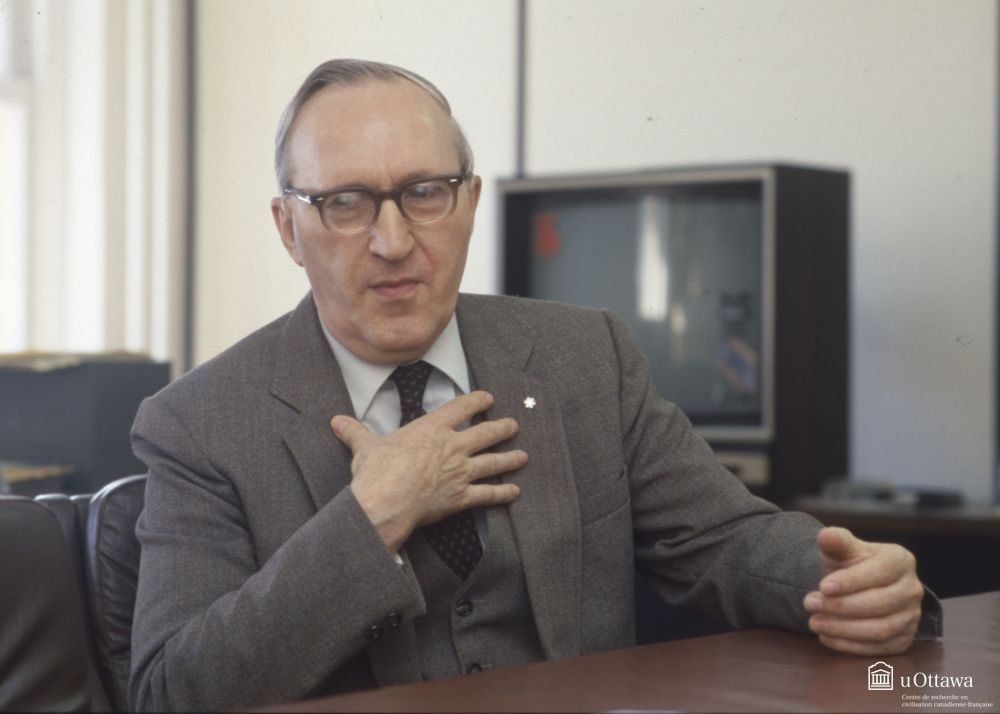Roland Galarneau, CM, machinist and inventor (born 16 February 1922 in Hull, Quebec; died 22 May 2011 in Hull). In the late 1960s, Galarneau invented the Converto-Braille, a computerized printer capable of transcribing text into Braille at 100 words per minute. This was a landmark innovation for people with visual impairments, as it increased their access to textbooks and other written information. Galarneau developed faster versions of the Converto-Braille in the 1970s. The company he founded eventually adapted the machine into software for IBM computers in the 1980s. This software was a precursor of the Braille software used today.

Roland Galarneau, who invented the Converto-Braille in the 1970s, pictured on 30 January 1985.
Key Terms
Braille — A system of writing for people with visual impairments that represents characters with patterns of raised dots.
Early Life and Education
Roland Galarneau was born with only 2 per cent of his vision. He received his primary education at the Institut Nazareth in Montreal, one of the first institutes in Canada to teach Braille.
After graduating, Galarneau worked with his father at the Iron Steel Company in Hull, Quebec. When the company closed after the Second World War, Galarneau found a job as a janitor for the federal Department of Public Works. To further his education, he signed up for night classes in engineering at the University of Ottawa. He also taught himself to do mechanical work, and he was promoted to machinist at Public Works.
Invention of the Converto-Braille
In 1952, Roland Galarneau built a microscope that allowed him to read engineering materials and instructions letter by letter. He referred to this as the “greatest moment” of his life because it was the first time he could read print. Galarneau called this invention the “roloscope.” This experience inspired him to try to increase Braille usage, and in the early 1960s he had the idea to develop a computerized machine that would convert Latin-alphabet texts into Braille. He thought that if Braille became easier and cheaper to produce, more people would read it and more up-to-date texts would be published.
“A lot of blind people refuse to read Braille because they can’t find up-to-date material.”
— Roland Galarneau, 1980
From his basement workshop, Galarneau began work on this machine in 1966. Computers were costly at this time, so he set about creating his own from scratch. He envisioned a machine that could quickly convert text to Braille without the machine operator having to know Braille. The stroke of a letter key would send an electrical signal that activated relays (mechanical switches) along a “decision tree.” Galarneau programmed the decision tree to determine which Braille letter, contraction or word to print, based on the keystroke inputs. These actions moved a group of pins that punctured paper to create Braille symbols. Galarneau often had help from his family, and his good friend Adrien Filiatreault built much of the circuitry. After more than 10,000 hours of work, the first prototype of his device, called the Converto-Braille, was complete.

The prototype of Roland Galarneau's Converto-Braille (c. 1972), a computerized device that could transcribe written text into Braille.
Jeanne Cypihot, a philanthropist and Galarneau’s former teacher, heard of his project and donated money to it. Galarneau formed Cypihot-Galarneau Converto-Braille Services, a non-profit corporation, in 1970. Two years later, he was able to hire a team. They worked on converting college and university textbooks into Braille. Some staff also worked on a project to record French-language audiobooks in partnership with the University of Ottawa. This became the first French-language audiobook library in Canada. It contained 3,500 titles. In 1976, Galarneau was appointed to the Order of Canada for “work[ing] his entire life to improve the lot of the blind, particularly in college education.”
In the 1970s, the Converto-Braille evolved from the original 100 word-per-minute manual system to faster models.
Later Life
In 1980, Roland Galarneau began publishing a Braille version of Hull’s local newspaper, Le Régional, free of charge, with his new equipment. It went to about 50 Braille readers in the area. Galarneau told Maclean’s magazine that he was motivated by his own desire to read the newspaper, as his father had always done after supper. “I always wanted to be able to do it too,” he said. “There was something missing in my life.”
He also used the Converto-Braille to transcribe books and pamphlets. Other projects followed throughout the 1980s, making the Converto-Braille the catalyst for increased production of Braille texts.
Galarneau retired in 1987 but continued his research. His son took over the management of his company and oversaw the adaptation of the Converto-Braille into software for IBM computers.
Roland Galarneau died on 22 May 2011 at the age of 89.
“In my mind, I had to do things on my own in order to grow and to be able to do what others do. That was very important to me.”
— Roland Galarneau, c. 1987

 Share on Facebook
Share on Facebook Share on X
Share on X Share by Email
Share by Email Share on Google Classroom
Share on Google Classroom




